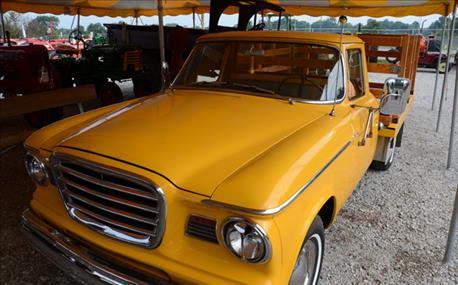
OK, maybe you didn’t know the Indiana automaker Studebaker even produced a pickup truck. It did. But that’s not one of the six things you are about to learn about its Champ truck, produced from 1960 to 1964. Consider that a freebie fact.
Memories of the Champ were rekindled when a perfect specimen was displayed in a tent for tractors and trucks made only in Indiana at the Indiana State Fair's Pioneer Village this year. The exhibit was in honor of Indiana’s bicentennial year.
Here are six things you likely didn’t know about Studebaker pickup trucks. Thanks to Wikipedia for providing the information for this article.

1. The Champ model introduced in 1960 used a chassis and cargo box from half- and three-quarter-ton models used since 1949. The Champ was the first new model from Studebaker in a decade. Engineers were strapped with limited budgets due to slumping sales.
2. The truck cab was modeled off of Studebaker’s Lark car model. And that actually might be an understatement. Word is that engineers cut a Lark in half behind the front doors of a four-door sedan. The result was a perfect fit, and the truck cab was modified from there.

LEFT ITS MARK: The Studebaker Champ pickup didn’t save the company financially, but it did leave its mark on history. This cream puff was displayed in the Indiana-made-only exhibit at the state fair.
3. Studebaker introduced the sliding rear window. Believe it or not, the sliding back window that is still popular on trucks today first appeared on the Champ pickup by Studebaker. It was a feature on Champ models from the start, and is considered one of Studebaker’s better ideas. Most major manufacturers were offering sliding rear windows within a short time of Studebaker's introduction, and it remains a universal feature on many pickups today. If you want to win in a game of trivia, ask which company first introduced the sliding rear window. You’re almost a guaranteed winner!
4. Studebaker was the first company to introduce a pickup with carlike comfort. Since the cab was directly patterned after the front half of a car, the interior truly had carlike comfort. It was several years before most other manufacturers followed Champ’s lead.
5. The Champ was one of the first American trucks, if not the first, to offer service bodies constructed of fiberglass. The steel service body is still the most common today in pickups. However, service bodies made of fiberglass and composites have gained acceptance ever since the concept was introduced, quite likely on the Champ in 1960.
6. The truck pointed the way to future smaller yet still rugged pickups. Twenty-seven years later, Dodge would claim to have produced the first small but rugged pickup, the Dakota — classified as a midsize line. Yet many automotive historians believe one could argue that the Champ actually pioneered the concept of a smaller yet rugged pickup truck.
About the Author(s)
You May Also Like




